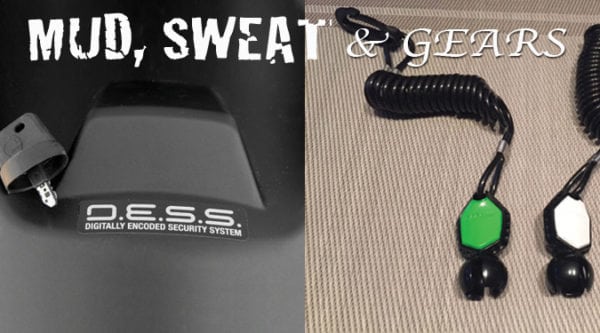Who Says You CAN’T Teach an Old Dog New Tricks?
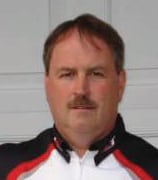 Story and Images by Randy Hall
Story and Images by Randy Hall
As a professional Technician and a Professor teaching in the trades, I came to the conclusion many years ago that you will never know everything in your profession, and therefore, you need to stay active in upgrading your knowledge. This can’t be truer than it is when teaching in the Motive Power Profession. When teaching apprentices, who are exposed to the latest and greatest technology at work every day, it is really hard to stay ahead of the curve, and have the knowledge to be effective as a teacher.
Fortunately, I have a good friend that owns a recreational equipment dealership, and when I asked him if I could work part-time for him to help re-hone my skills, he accepted my resume and put me to work.
I am enjoying the “mechanical repair” aspect of the job, but I am finding that the floor seems to be further away than it was in my younger days, all of my calluses on my hands are gone, and I have sore muscles that I forgot even existed. Bottom line, I am now aware of how out of shape I am.
I never thought about it before, but it is quite enjoyable moving from the role of teacher, and becoming the student again. After all, I am still a gear head, and I still really enjoy getting my hands dirty, especially on ATVs, side by sides, snowmobiles, motorcycles and personal watercraft. I also have the benefit of working with a great group of people, and we really work well together. If you need a hand, someone is always there to lend one, and although I am sure that they sometimes must chuckle to themselves, they take the time to answer any question I have, no matter how rudimentary it is.
After a couple of months though, I wanted to know where I stood as a competent “wrench”. (Technician)
One way I used to gauge my progress was to compare my actual repair times to OEM (Original Equipment Manufacturer) factory allotted times. In some circles, it’s referred to as the “flat rate” time allowed to perform a task and/or repair. This gives most technicians, myself included, a ballpark idea as to where they stand. I say ballpark because the way these times are developed, especially OEM warranty times, are in my opinion, not always fair to the technician or to the dealership.
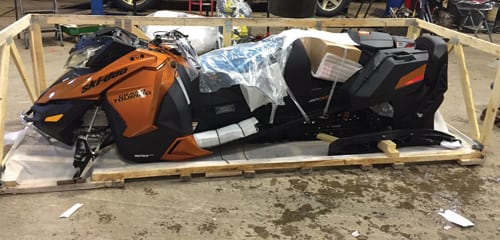
You can see that when you open the shipping crate, a lot of “good stuff” can be hiding in there. Manufacturers carefully design the crates to maximize space and prevent damage during shipment
The manufacturer usually will reference that the times are based on the ability of an “average skilled technician”. Now, I’m not sure exactly how you qualify someone as an average technician. I would also like to know how many times the technician did the specific repair on the same specific vehicle before the length of time was adopted as the “standard”. Also, was the environment ideal for the repairs? Basically, were all the special tools required available, was all lifting and supporting equipment there, and no interruptions by colleagues, salespersons or the boss. My point here, is that when developing these times, the environment is geared to the final outcome and completion for the task at hand, and at the end of the day, can someone sustain this pace of work for 8 to 9 hours?
So….after my bit of a rant, I figure I am at about 70% of a seasoned “above average” technician, currently working in the industry.
The OEM however, has also made some things easier and more streamlined to help with the ease of installation of accessories. Examples of this would be marking snowmobile tracks to increase the accuracy and efficiency of studding, and marking the frame with very light dimples where bolts holes need to be drilled for accessory mounting and installation.
One of the other big changes I found was the differences between the different models. Back
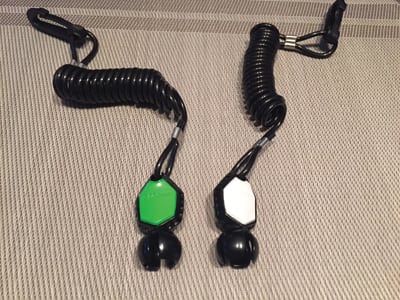
The green fob will drastically limit the performance of the vehicle for operators with limited experience while the grey allows regular operation.
when my dad had a Snow Jet and Kawasaki dealership, although we had different models, the foundations or platforms of the machines were somewhat common. Now there are more units with specific platforms for specific needs or purposes. This would include differences in sport, work, and two-up configurations to name a few. From suspension on the skis, the type of track it is using, high tech 2 or 4 stroke engine design, and the operator and passenger creature comforts of touring machines. The technician is expected to know it all thoroughly.
The way vehicles are shipped from the factory is now quite unique and very compact. Recreational vehicles now can be very large in size, and it is amazing how big of a vehicle can come out of a much smaller box. Back when I worked for my dad, on a snowmobile or motorcycle (no ATVs at this time yet) there was not as much to install. The front tire and handle bars on MX and enduro motorcycles, (some larger street bikes maybe had some fenders, windshields, batteries and signal lights to install) while snowmobiles, depending on the options such as electric start, in many cases only had the windshield to install.
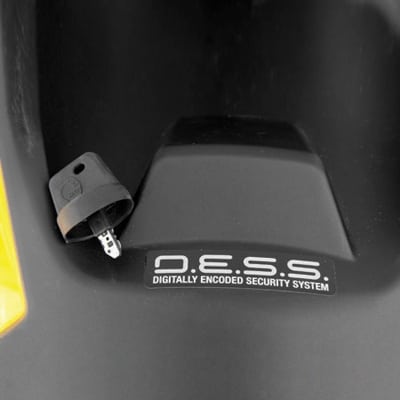
The DESS System is found on BRP Products
To finish it off, as with everything, there are the electronic devices and controls. At one time, to change from miles to kilometers, the speedometer cable was moved from one place to another on the speedometer. Most electric accessories were hard wire and switches. The throttle was adjusted by a cable, and carburetors were synchronized. Now, a laptop configures and calibrates everything accurately in a few short minutes, whereas before, mechanical adjustments had to be made. Throttle levers are now connected to the engine by wires instead of sliding cables on some engines. Two ideas I really like are the “learning keys” that de-rate the engine for learners, and the multi-switches for eco-mode, standard mode and my favorite, sport mode. With the simple movement of a switch, you can change the personality of the vehicle. Fortunately, the electronics/programming area is one place that I haven’t gotten too rusty in.
This old dog doesn’t have to roll over and play dead just yet.

